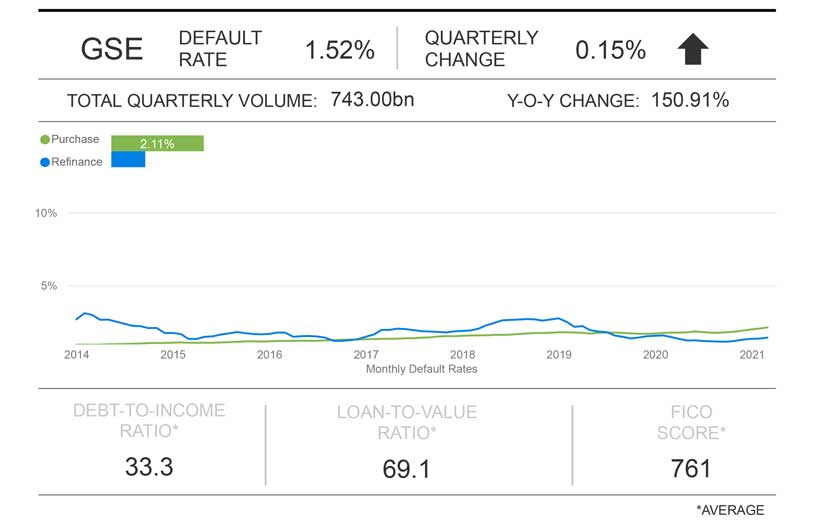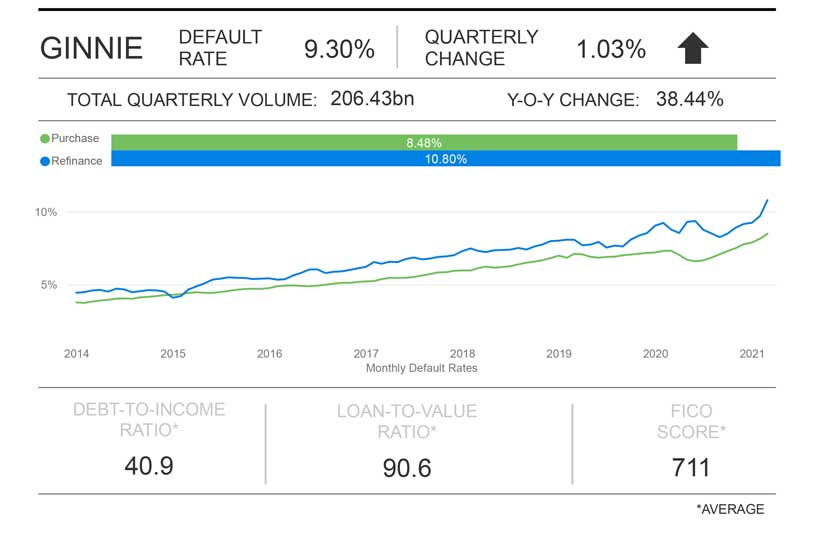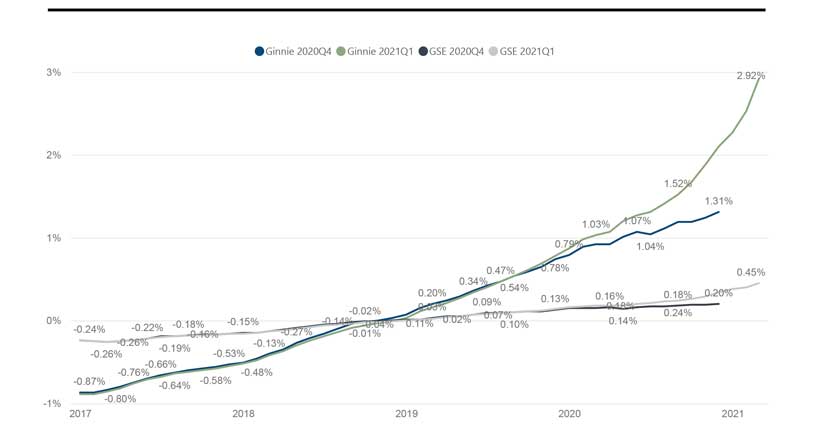The Milliman Mortgage Default Index (MMDI) is a lifetime default rate estimate calculated at the loan level for a portfolio of single-family mortgages. For the purposes of this index, default is defined as a loan that becomes 180 days or more delinquent.1 The results of the MMDI reflect the most recent data acquisition available from Freddie Mac, Fannie Mae, and Ginnie Mae, with measurement dates starting from January 1, 2014.
COVID-19 effects on mortgage risk
Significant uncertainty continues regarding how mortgage performance may be affected by the COVID-19 pandemic and its associated economic impacts. While unemployment rates, delinquency rates, and the percentage of loans in forbearance have increased rapidly since the start of the pandemic (and remain at elevated levels), the housing market has remained resilient. Please refer to prior releases of the MMDI,2 as well as recent Milliman articles on the topic,3 for more detailed discussions of the potential impact of the pandemic on mortgage performance.
Key findings
Freddie Mac and Fannie Mae mortgage originations during the first quarter (Q1) of 2021 remained elevated but decreased from the prior quarter. The decline in overall volume is attributable to a decrease in refinance mortgages, which slightly declined with increases in mortgage interest rates.
The total default risk quarter-over-quarter for government-sponsored enterprise (GSE) acquisitions—loans acquired by Freddie Mac and Fannie Mae—increased, at 1.52% for loans originated in 2021 Q1 compared to 1.38% for loans originated in 2020 Q4 as a result of elevated economic risk. This is the first time since Milliman began producing the MMDI that GSE default risk has increased. Figure 1 provides the quarter-end index results for these loans segmented by purchase and refinance.
FIGURE 1: MMDI 2021 Q1 DASHBOARD FOR GSE LOANS

The MMDI for Ginnie Mae loans increased from 8.27% in 2020 Q4 to 9.30% in 2021 Q1, as can be seen in Figure 2 (segmented by purchase and refinance). For certain types of refinance loans (i.e., streamlined refinance loans), Ginnie Mae acquisitions do not receive an updated credit score. For the MMDI, a credit score of 600 is conservatively used to calculate the default risk on mortgages with a missing credit score. Because a large portion of volume was refinance volume, many Ginnie Mae loans are getting assigned a low credit score of 600.
FIGURE 2: MMDI 2021 Q1 DASHBOARD FOR GINNIE LOANS

When reviewing quarter-over-quarter changes in the MMDI, it is important to note that the 2020 Q4 MMDI values for GSE and Ginnie Mae acquisitions have been restated since the last publication, changing from 1.27% to 1.38% and 7.64% to 8.27%, respectively, with the increase in the default rate driven predominantly by a revised lower long-term home price forecast. This is a result of updating actual home price movements from forecasted values and updating home price appreciation forecasts with the most recent forecasts available. The most recent forecast of home prices estimates slower long-term appreciation relative to prior forecasts. It is assumed that the current level of rapid appreciation will slow down as housing inventory returns to the market along with a general emergence from the pandemic.
Agency summary
Interact with the MMDI

To explore the MMDI data on a more granular level, including loan origination and type, click here.
For the first time since the start of this publication (2019 Q1), there has been an increase in the default risk for Freddie and Fannie acquisitions compared to the prior quarter. It is important to note the main driver of the increase in default risk arises from a more pessimistic long-term home price forecast. Borrower and underwriting risk were generally consistent quarter to quarter. Loans guaranteed by Ginnie Mae also experienced an increase in their default risk in 2021 Q1 relative to the prior quarter.
This is predominantly due to the decrease in volume of refinance loans for both GSE and Ginnie originations compared to last quarter.
Components of Default Risk
The components of the MMDI that inform default risk are borrower risk, underwriting risk, and economic risk. Borrower risk measures the risk of the loan defaulting due to borrower credit quality, initial equity position, and debt-to-income ratio. Underwriting risk measures the risk of the loan defaulting due to mortgage product features such as amortization type, occupancy status, and other factors. Economic risk measures the risk of the loan defaulting due to historical and forecasted economic conditions.
BORROWER RISK RESULTS: 2021 Q1
For GSE loans, borrower risk remained consistent at 1.03% in 2021 Q1 relative to 2020 Q4. The continued low level of borrower default risk in 2020 Q4 is attributable to the majority of loans being refinance, which has lower average loan-to-value (LTV) ratios and higher credit scores. For Ginnie Mae loans, borrower risk increased in 2021 Q1 relative to 2020 Q4 from an average of 5.87% to 6.11%. Ginnie Mae loans are generally lower credit score/higher LTV ratio loans.
UNDERWRITING RISK RESULTS: 2021 Q1
Underwriting risk represents additional risk adjustments for property and loan characteristics such as occupancy status, amortization type, documentation types, loan term, and others. Underwriting risk after the global financial crisis remains low and is negative for purchase mortgages, which were generally full-documentation, fully amortizing loans.
ECONOMIC RISK RESULTS: 2021 Q1
Economic risk is measured by looking at historical and forecasted home prices. Actual home price appreciation has been robust from 2014 through 2021, which has resulted in embedded appreciation for older originations. This results in reduced default risk for older cohorts. For more recent cohorts, we anticipate slower home price growth (or negative growth for some local geographies) after housing supply returns post-pandemic, which contributes to increases in economic risk for recent origination years.
Figure 3 shows the economic risk component of the MMDI for Ginnie Mae mortgages and GSE mortgages as of 2020 Q4 and 2021 Q1. What we notice from the chart is that economic risk has remained steady, but sharply increases for newer originations.
FIGURE 3: ECONOMIC RISK BY INVESTOR AND ORIGINATION

While the current level of robust home price growth is certainly a function of the pandemic and supply/demand imbalances, it is difficult to estimate how home prices may react “post-pandemic.” The MMDI reflects a baseline forecast of future home prices. To the extent actual or baseline forecasts diverge from the current forecast, future publications of the MMDI will change accordingly. Please read the disclaimer for COVID-19 for more context on economic risk.
For more detail on the MMDI components of risk, visit milliman.com/MMDI.
About the Milliman Mortgage Default Index
Milliman is expert in analyzing complex data and building econometric models that are transparent, intuitive, and informative. We have used our expertise to assist multiple clients in developing econometric models for evaluating mortgage risk both at the point of sale and for seasoned mortgages.
The Milliman Mortgage Default Index (MMDI) uses econometric modeling to develop a dynamic model that is used by clients in multiple ways, including analyzing, monitoring, and ranking the credit quality of new production, allocating servicing sources, and developing underwriting guidelines and pricing. Because the MMDI produces a lifetime default rate estimate at the loan level, it is used by clients as a benchmarking tool in origination and servicing. The MMDI is constructed by combining three important components of mortgage risk: borrower credit quality, underwriting characteristics of the mortgage, and the economic environment presented to the mortgage. The MMDI uses a robust data set of over 30 million mortgage loans, which is updated frequently to ensure it maintains the highest level of accuracy.
Milliman is one of the largest independent consulting firms in the world and has pioneered strategies, tools, and solutions worldwide. We are recognized leaders in the markets we serve. Milliman insight reaches across global boundaries, offering specialized consulting services in mortgage banking, employee benefits, healthcare, life insurance and financial services, and property and casualty insurance. Within these sectors, Milliman consultants serve a wide range of current and emerging markets. Clients know they can depend on us as industry experts, trusted advisers, and creative problem-solvers.
Milliman's Mortgage Practice in Milwaukee is dedicated to providing strategic, quantitative, and other consulting services to leading organizations in the mortgage banking industry. Past and current clients include many of the nation's largest banks, private mortgage guaranty insurers, financial guaranty insurers, institutional investors, and governmental organizations.
1For example, if the MMDI is 10%, then we expect 10% of the mortgages originated in that month to have become 180 days or more delinquent over their lifetimes.
2The MMDI report on 2019 Q2, for example, is available at https://us.milliman.com/en/insight/mortgage-default-index-2019-q2.